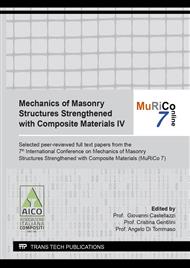[1]
F. Bencardino, C. Carloni, A. Condello, F. Focacci, A. Napoli, R. Realfonzo, Flexural behaviour of RC members strengthened with FRCM: State-of-the-art and predictive formulas, Compos Part B. 148 (2018) 132–148. https://doi.org/10.1016/j.compositesb.2018.04.051.
DOI: 10.1016/j.compositesb.2018.04.051
Google Scholar
[2]
L. Ombres, Debonding analysis of reinforced concrete beams strengthened with fibre reinforced cementitious mortar, Eng Fract Mech. 81 (2012) 94–109.
DOI: 10.1016/j.engfracmech.2011.06.012
Google Scholar
[3]
M.Y. Alabdulhady, L.H. Sneed, C. Carloni, Torsional behavior of RC beams strengthened with PBO-FRCM composite – An experimental study, Engineering Structures. 136 (2017) 393–405.
DOI: 10.1016/j.engstruct.2017.01.044
Google Scholar
[4]
T. D'Antino, F. Focacci, L.H. Sneed, C. Carloni, Relationship between the effective strain of PBO FRCM-strengthened RC beams and the debonding strain of direct shear tests, Engineering Structures. 216 (2020) 110631. https://doi.org/10.1016/j.engstruct.2020.110631.
DOI: 10.1016/j.engstruct.2020.110631
Google Scholar
[5]
V. Alecci, F. Focacci, L. Rovero, G. Stipo, M. De Stefano, Intrados strengthening of brick masonry arches with different FRCM composites: Experimental and analytical investigations, Compos Struct. 176 (2017) 898–909. https://doi.org/10.1016/j.compstruct.2017.06.023.
DOI: 10.1016/j.compstruct.2017.06.023
Google Scholar
[6]
T. D'Antino, F.G. Carozzi, C. Poggi, Diagonal shear behavior of historic walls strengthened with composite reinforced mortar (CRM), Mater Struct. 52 (2019) 114.
DOI: 10.1617/s11527-019-1414-1
Google Scholar
[7]
Bakis C. E., Bank Lawrence C., Brown V. L., Cosenza E., Davalos J. F., Lesko J. J., Machida A., Rizkalla S. H., Triantafillou T. C., Fiber-Reinforced Polymer Composites for Construction—State-of-the-Art Review, Journal of Composites for Construction. 6 (2002) 73–87.
DOI: 10.1061/(asce)1090-0268(2002)6:2(73)
Google Scholar
[8]
C. Carloni, D.A. Bournas, F.G. Carozzi, T. D'Antino, G. Fava, F. Focacci, G. Giacomin, G. Mantegazza, C. Pellegrino, C. Perinelli, C. Poggi, Chapter 9 - Fiber reinforced composites with cementitious (inorganic) matrix., in: Design Procedures for the Use of Composites in Strengthening of Reinforced Concrete Structures: A State of the Art Report of the RILEM TC 234-DUC, Pellegrino C, Sena-Cruz J, 2015: p.349–392.
DOI: 10.1007/978-94-017-7336-2_9
Google Scholar
[9]
J. fei Chen, J.G. Teng, Anchorage Strength Models for FRP and Steel Plates Bonded to Concrete, J Struct Eng. 127 (2001) 784–791.
DOI: 10.1061/(asce)0733-9445(2001)127:7(784)
Google Scholar
[10]
National Research Council, Guide for the design and construction of externally bonded fibre reinforced inorganic matrix systems for strengthening existing structures. CNR-DT 215/2018, CNR, Rome, Italy, (2020).
Google Scholar
[11]
F.G. Carozzi, C. Poggi, Mechanical properties and debonding strength of Fabric Reinforced Cementitious Matrix (FRCM) systems for masonry strengthening, Composites Part B: Engineering. 70 (2015) 215–230. https://doi.org/10.1016/j.compositesb.2014.10.056.
DOI: 10.1016/j.compositesb.2014.10.056
Google Scholar
[12]
R. Contamine, A. Si Larbi, P. Hamelin, Contribution to direct tensile testing of textile reinforced concrete (TRC) composites, Mater Sci And Eng A. 528 (2011) 8589–8598.
DOI: 10.1016/j.msea.2011.08.009
Google Scholar
[13]
ACI Committee 549, Guide to Design and Construction of Externally Bonded Fabric-Reinforced Cementitious Matrix and Steel-Reinforced Grout Systems for Repair and Strengthening of Concrete Structures. ACI 549.4R-20, ACI, Farmington Hill, US, (2020).
DOI: 10.14359/51663675
Google Scholar
[14]
ACI Committee 549, Guide to Design and Construction of Externally Bonded Fabric-Reinforced Cementitious Matrix (FRCM) and Steel-Reinforced Grout (SRG) Systems for Repair and Strengthening Masonry Structures. ACI 549.6R-20, ACI, Farmington Hill, US, (2020).
DOI: 10.14359/51663675
Google Scholar
[15]
International Code Council Evaluation Service (ICC-ES), Acceptance criteria for masonry and concrete strengthening using fabric-reinforced cementitious matrix (FRCM) and steel reinforced grout (SRG) composite systems. AC434, Whittier, CA, (2018).
DOI: 10.14359/51702356
Google Scholar
[16]
D. Arboleda, F.G. Carozzi, A. Nanni, C. Poggi, Testing Procedures for the Uniaxial Tensile Characterization of Fabric-Reinforced Cementitious Matrix Composites, J Compos Constr. 20 (2016) 04015063. https://doi.org/10.1061/(ASCE)CC.1943-5614.0000626.
DOI: 10.1061/(asce)cc.1943-5614.0000626
Google Scholar
[17]
F. Focacci, T. D'Antino, C. Carloni, Tensile tests of FRCM coupons: the influence of the fiber-matrix bond properties, in: Proc. of the 10th International Conference on Fibre-Reinforced Polymer (FRP) Composites in Civil Engineering, CICE 2021, Istanbul, (2021).
DOI: 10.1007/978-3-030-88166-5_173
Google Scholar
[18]
F. Focacci, T. D'Antino, C. Carloni, The role of the fiber–matrix interfacial properties on the tensile behavior of FRCM coupons, Construction and Building Materials. 265 (2020) 120263. https://doi.org/10.1016/j.conbuildmat.2020.120263.
DOI: 10.1016/j.conbuildmat.2020.120263
Google Scholar
[19]
C. Carloni, T. D'Antino, L.H. Sneed, C. Pellegrino, Role of the Matrix Layers in the Stress-Transfer Mechanism of FRCM Composites Bonded to a Concrete Substrate, Journal of Engineering Mechanics. 141 (2015) 04014165. https://doi.org/10.1061/(ASCE)EM.1943-7889.0000883.
DOI: 10.1061/(asce)em.1943-7889.0000883
Google Scholar


